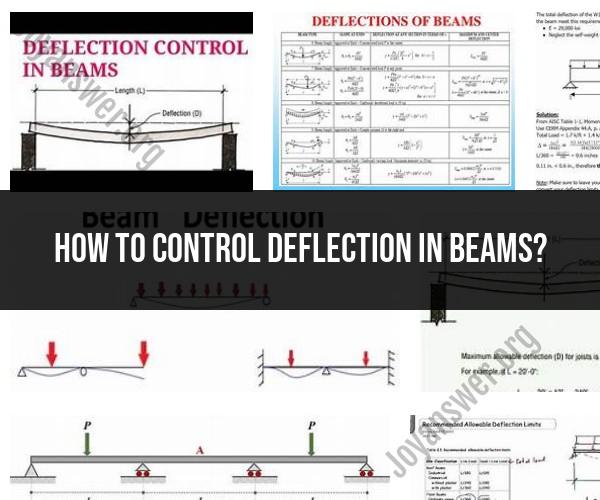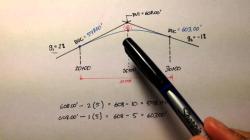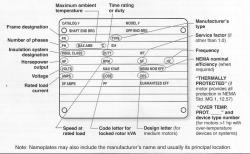How to control deflection in beams?
Controlling deflection in beams is an important aspect of structural engineering to ensure that a structure can safely support loads without excessive bending or deformation. Here are some engineering techniques to control deflection in beams:
Choose the Right Material:
- Using a material with a higher modulus of elasticity (Young's modulus) can reduce deflection. Materials like steel and reinforced concrete have high modulus values and are often used in structures where deflection control is critical.
Select Beam Geometry:
- The shape and dimensions of the beam can significantly affect its deflection. A deeper or wider beam is less likely to deflect than a shallower or narrower one. Choose beam dimensions that suit the structural requirements while minimizing deflection.
Increase Beam Stiffness:
- Beam stiffness is a function of its material properties and cross-sectional geometry. You can increase stiffness by using thicker or deeper beams, adding flanges, or using materials with a higher modulus of elasticity.
Use Reinforcement:
- Reinforced concrete beams can be strengthened with the addition of steel reinforcement, such as rebar or mesh, which enhances their ability to resist deflection.
Limit Span Length:
- Reducing the span length between supports can effectively limit deflection. Shorter spans experience less deflection than longer ones. Consider adding more support points or using intermediate columns to reduce spans.
Add Support:
- Increasing the number of support points under the beam can distribute the load more evenly and reduce deflection. This approach is often used in long-span structures like bridges.
Apply Point Loads Carefully:
- If loads are applied at specific points along the beam, ensure that these points align with the beam's points of maximum bending resistance (e.g., at the supports or under beams and girders). This minimizes the effects of concentrated loads on deflection.
Use Deflection-Reducing Devices:
- In some cases, you can use deflection-reducing devices like structural bracing, trusses, or tension cables to provide additional support and control deflection.
Consider Prestressing:
- Prestressed concrete or steel beams can be used to counteract deflection by introducing compressive forces that offset the tensile forces created by loads. This is common in bridge construction.
Perform Structural Analysis:
- Conduct a thorough structural analysis using engineering software or calculations to predict and evaluate deflection. This allows you to optimize beam size and reinforcement based on the expected loads and deflection limits.
Comply with Building Codes:
- Follow the building codes and standards relevant to your project, as they often specify maximum allowable deflection limits for different types of structures.
Regular Inspection and Maintenance:
- After construction, regular inspection and maintenance are essential to ensure that the beams continue to perform as expected and that deflection remains within acceptable limits over time.
Controlling deflection is crucial for maintaining structural integrity and safety in buildings, bridges, and other structures. Engineers carefully design and analyze beams to ensure they meet the required deflection criteria for specific applications.
Beam Deflection Control: Strategies and Techniques
Beam deflection is the downward displacement of a beam when it is subjected to a load. It is an important consideration in the design and construction of beams, as excessive deflection can lead to structural failure.
There are a number of strategies and techniques that can be used to control beam deflection. Some of the most common include:
- Increasing the beam depth: The deeper the beam, the more resistant it is to deflection.
- Using wider beams: Wider beams have a greater moment of inertia, which makes them more resistant to deflection.
- Using higher strength materials: Stronger materials, such as steel and high-performance concrete, are more resistant to deflection than weaker materials, such as wood and low-strength concrete.
- Using reinforcement: Reinforcement, such as steel rebar, can be used to strengthen beams and make them more resistant to deflection.
- Reducing the load: Reducing the load on a beam will reduce the amount of deflection. This can be done by using lighter materials or by distributing the load more evenly.
Managing Beam Deflection: Methods for Structural Stability
In addition to the strategies listed above, there are a number of other methods that can be used to manage beam deflection in structural design. These include:
- Using pre-stressed beams: Pre-stressed beams are beams that have been subjected to a compressive force before the load is applied. This compressive force helps to offset the tensile force caused by the load, which reduces deflection.
- Using composite beams: Composite beams are beams that are made up of two or more different materials, such as steel and concrete. The different materials are bonded together to create a beam that is stronger and more resistant to deflection than a beam made from a single material.
- Using camber: Camber is a slight upward curvature that is given to a beam during construction. This curvature helps to offset the deflection that will occur when the load is applied, resulting in a straighter beam.
Controlling Deflection in Beams: Engineering Approaches
Engineers use a variety of methods to control deflection in beams. The specific method used will depend on the specific design requirements and the constraints of the project.
Some of the most common engineering approaches to controlling beam deflection include:
- Using finite element analysis (FEA): FEA is a computer-based method that can be used to simulate the behavior of beams and other structures under load. FEA can be used to identify areas of high stress and deflection, and to design beams that are resistant to these forces.
- Using structural optimization: Structural optimization is a process of finding the most efficient design for a beam or other structure. This process can be used to reduce the weight and cost of beams while still meeting the required performance criteria.
- Using performance-based design: Performance-based design is a design approach that focuses on the performance of a structure under load, rather than simply the strength of the individual components. This approach can be used to design beams that are more resilient to damage and that can continue to function even in the event of a failure.
By using these and other engineering approaches, engineers can design beams that are resistant to deflection and that can meet the specific requirements of each project.













